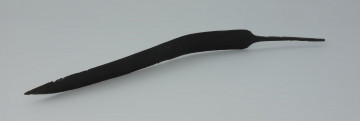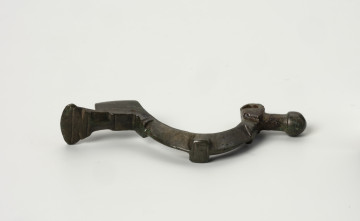
Two-edged sword
National Museum in Szczecin
Part of the collection: Antiquity
The pottery vessel belongs to a specific type of vases, described due to their shape as “inversely pear-shaped” or “situla-shaped”, from the Latin word situla, meaning a bucket. Situli are the bronze buckets, which were imported from Rome and discovered all over northern Europe, and most probably served as models for ceramic vessels. The surface of the situla from Iglice is black and carefully smoothed. It is decorated with classic meandric motives running all around the body. The pottery with such a high level of craftsmanship was made for the needs of funeral rites. Situla vessels have also been discovered in settlements, but they are much less carefully made. The presented vessel was discovered by chance at the end of the 19th century in the gravel pit in Iglice. The discovery led to uncovering the cremation burials which belonged to one or two cemeteries, and several pottery vessels, bronze fibulae and a bronze belt buckle. The morphology and ornamentation of the situla-shaped vessel indicate the tradition of the earlier Roman imperial period in the 1st century. Together with the other mentioned objects, it should be associated with the people of the Wielbark culture who occupied most of Pomerania between the 1st and mid-5th centuries. This culture, named after one of the cemeteries in Wielbark near Malbork, was characterised by their bi-ritual burial rites - the dead were buried both in inhumation ad cremation graves, sometimes in coffins made of logs. The lack of iron objects and weapons in grave goods is also characteristic of the Wielbark culture. An inhumation grave, furnished with a Roman glass vessel is also known from the same location, which allows dating the burial to the late Roman period, 2nd - 3rd century. It appears that the Iglice area was intensively settled throughout the entire Roman imperial period.
Bartłomiej Rogalski
Author / creator
Dimensions
cały obiekt: height: 28 cm, diameter: 28 cm
Object type
urn; furnishings and equipment; ash urn; container; vessel (container)
Technique
manual modelling
Material
clay
Creation / finding place
Owner
Muzeum Narodowe w Szczecinie
Identification number
Location / status

National Museum in Szczecin

250 — 300
National Museum in Szczecin

around 150 — 375
National Museum in Szczecin
DISCOVER this TOPIC
Castle Museum in Łańcut
DISCOVER this PATH
Educational path